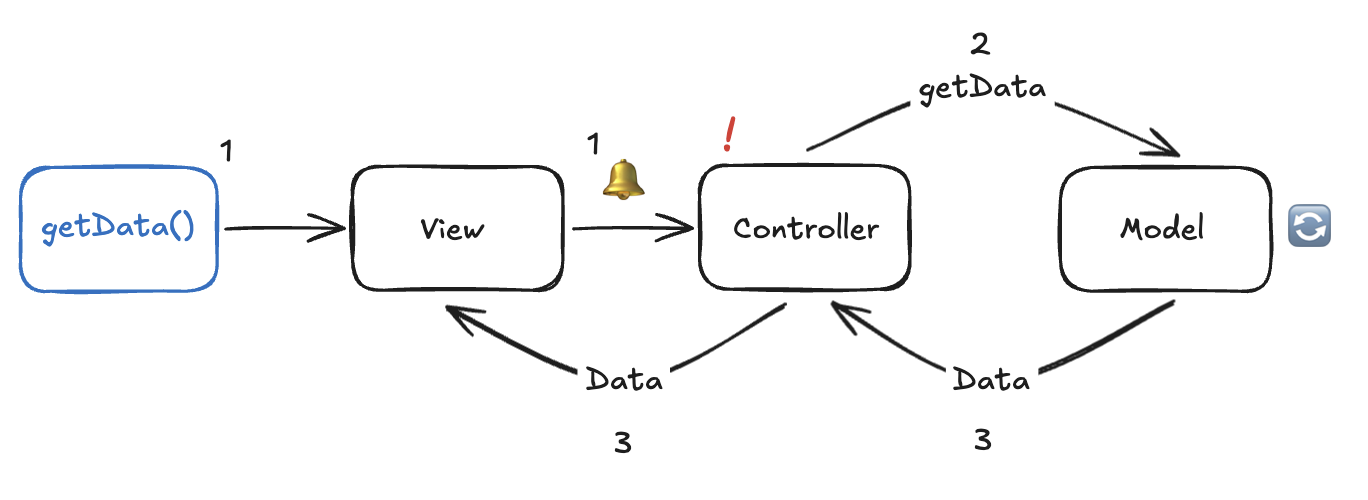Appearance
Structural Patterns
Last Updated: March 23, 2025
Structural patterns help organize and manage relationships between objects to form larger structures and enhance flexibility and reusability.
WARNING
I am only sharing the patterns I have interacted with!
TL;DR
Adapter: Makes incompatible interfaces compatible by acting as a translator.Model-View-Controller: Separates data, interface, and control logic for organized structure.Model-View-ViewModel: Enhances MVC by adding a ViewModel, which acts as a bridge between Model and View, allowing data binding and cleaner separation of business logic and UI.
Adapter Pattern
Definition
The Adapter Pattern allows two incompatible interfaces to work together by creating a middleman (adapter) that translates between them.

Think about when you are traveling: when you decide to travel to a different continent, it's complicated to use a power outlet! That's where the plug adapter comes in, and helps you to adapt your charger. Same here!
Flow
Adapter Creation: The adapter class is created, implementing the interface and methods expected by the client.Adaptation: The adapter translates or maps requests from the client interface to the adaptee's interface.Usage: The client can now use the adapter as if it were using the original system or class.
Example - In Code
swift
// Target (What the client expects)
protocol LegacyPrinter {
func printText(_ text: String)
}swift
// Adaptee (New incompatible class)
class ModernPrinter {
func printModern(_ content: String) {
print("🖨️ Modern Printer Output: \(content)")
}
}swift
// Adpter
class PrinterAdapter: LegacyPrinter {
private let modernPrinter = ModernPrinter()
func printText(_ text: String) {
modernPrinter.printModern(text)
}
}Usage
swift
func sendToPrinter(printer: LegacyPrinter) {
printer.printText("Hello, Adapter Pattern!")
}Model-View-Controller (MVC)
Definition
The MVC is an architectural pattern that separates your code into 3 clear responsibilities:
Model: Manages the data and business logic.View: Handles the UI and what the user sees.Controller: Acts as the middleman — it connects the Model and the View. The goal here is to separate concerns so the code is easier to manage, test and update.
Think of your MVC as a restaurant:
- Model = The kitchen (prepares the food = data)
- View = The customer’s table (displays the food)
- Controller = The waiter (connects customer & kitchen)
Flow
- The
Viewreceives user input and notifies theController. - The
Controllerinteracts with theModelto get or update data. - Once the
Modelis updated of fetched, theControllerupdates theView.

Example - In Code
swift
// Model
struct User {
var name: String
}swift
// Controller
@Observable
class UserController {
private(set) var user: User = User(name: "Alice")
func changeUserName(to newName: String) {
user.name = newName
}
}swift
// View
import SwiftUI
struct UserView: View {
@State private var controller: UserController
var body: some View {
VStack(spacing: 20) {
Text("👤 User Name: \(controller.user.name)")
.font(.title)
Button("Change Name to Bob") {
controller.changeUserName(to: "Bob")
}
}
.padding()
}
}Model-View-ViewModel (MVVM)
Definition
The MVVM is a modern architectural pattern designed to separate concerns in UI applications. The goal: Keep your UI logic, business logic, and data model clean and separated.
- The
Modelis similar to MVC, which represents the data and business logic of the application. - The
Viewdisplays the user interface and binds to properties exposed by the ViewModel. - The
ViewModelacts as an intermediary between the Model and the View, and exposes data in a way that the View can easily consume.
Let's use our creativity again, and imagine a smart display screen:
- Model = The raw data (like API response or database info)
- ViewModel = The smart brain that formats, transforms, and prepares data for display
- View = The screen — shows what the ViewModel gives it and sends back user actions
Flow
- The
Viewbinds to properties in theViewModel. - When the
ViewModelreceives updates from theModelor processes user input, it notifies theViewof changes. - The
Viewupdates automatically based on the data bound to theViewModel.

Example - In Code
swift
// Model
extension App.Entities {
struct Category: Identifiable {
var id: UUID
var title: String
var color: Color
init(
id: UUID = UUID(),
title: String,
color: Color,
) {
self.id = id
self.title = title
self.color = color
}
}
}swift
// Here in order to interact with the data (SwiftData), I 'm using a repository.
extension App.Repositories {
struct CategoryRepository: App.Protocols.CategoryDataProviding {
@MainActor
static func fetch() async throws -> [CategoryEntity] {
let categoriesFetch = FetchDescriptor<CategoryResponseEntity>()
do {
let data = try getContext().fetch(categoriesFetch)
return data
.convert()
} catch {
print("Error: \(error.localizedDescription)")
throw error
}
}
}
}swift
// ViewModel
extension App.Views.CategoriesList {
@Observable @MainActor
final class ViewModel {
var categories: [App.Entities.Category] = []
func loadData() async {
do {
categories = try await App.Repositories.CategoryRepository.fetch()
} catch {
print("Error while loading data, \(error.localizedDescription)")
}
}
}
}swift
// View
import SwiftUI
extension App.Views {
struct CategoriesList: View {
@State private var viewModel = ViewModel()
var body: some View {
content
.task {
await viewModel.loadData()
}
.navigationTitle("categories")
}
}
}
private extension App.Views.CategoriesList {
var content: some View {
ScrollView {
LazyVGrid(columns: [GridItem(.flexible()), GridItem(.flexible())], spacing: DS.Spacing.large) {
ForEach(viewModel.categories) { category in
Text(category.title)
}
}
}
}
}